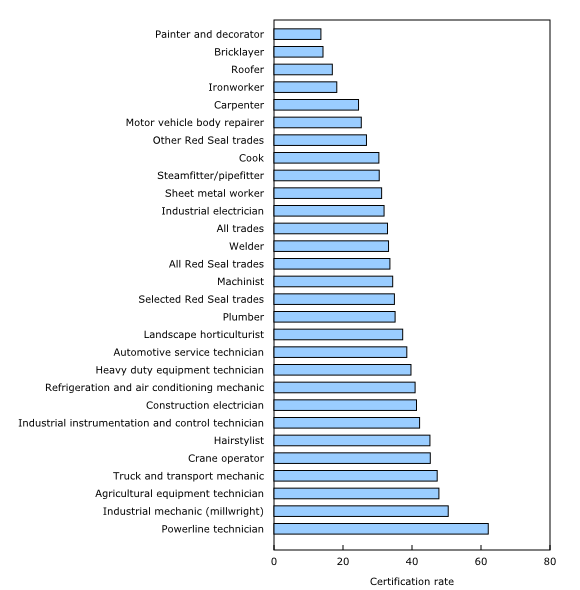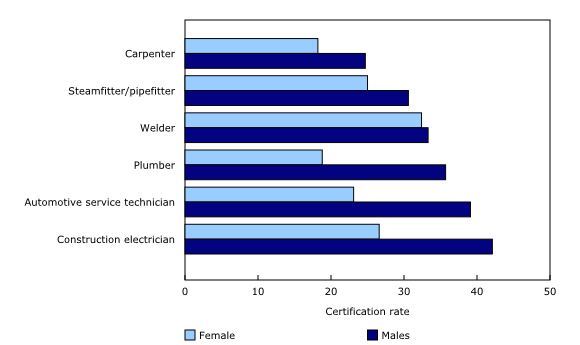Pathways indicators for registered apprentices in Canada, 2019
Archived Content
Information identified as archived is provided for reference, research or recordkeeping purposes. It is not subject to the Government of Canada Web Standards and has not been altered or updated since it was archived. Please "contact us" to request a format other than those available.
Released: 2021-06-24
In 2013, there were 93,430 apprentices who began their training. By 2019, six years into the program, those who registered in 2013 were less likely to certify in their trade and more likely to discontinue, compared with those who had registered in 2011 and 2012. This leads to growing concerns about the potential shortage of certified tradespeople or skilled workers as the population of certified tradespeople ages.
A new study available today looks at certification rates for apprentices who began their training in 2013 and where they were in 2019, six years into the program. This analysis serves as an important baseline for understanding the impacts of the COVID-19 pandemic on apprentices as they undergo or complete their training. Preliminary data from a recent Statistics Canada article suggest that the COVID-19 pandemic may have negatively impacted registrations and certifications in the trades in 2020, potentially adding to the declines in certification for apprentices.
Just under one-third of apprentices had certified in their trade six years after registration
Many apprentices take longer than the program duration to certify in their trade. Certifications and discontinuation rates among registered apprentices vary widely by trade and are influenced by many factors, such as age, previous apprenticeship training, type of trade and whether certifications are mandatory to work in the trade.
While program durations vary by province and trade, the most common program duration for all trades at the national level is four years.
In 2017, four years after registration, approximately one-fifth (20.9%) of the 2013 cohort of apprentices had completed their training and one-third (35.4%) had discontinued. By 2019, just under one-third of (32.9%) had certified, while almost half had discontinued (45.4%).
In 2019, six years after registering in their program, certification rates were highest among Red Seal trades, including powerline technician (62.1%), industrial mechanic (millwright) (50.5%), agricultural equipment technician (47.8%) and truck and transport mechanic (47.3%). At the same time, 10 of the 25 Red Seal trades had discontinuation rates greater than 50%, with the highest being ironworkers (66.2%), painter-decorators (62.1%) and motor vehicle body repairers (58.2%).
Apprenticeships are especially vulnerable to economic fluctuations, since most training requirements are dependent upon the completion of on-the-job hours. Economic downturns, such as the decline in oil prices from 2014 to 2016 that had greater effects on resource-rich provinces like Alberta, could negatively impact an apprentice's ability to maintain employment and meet the on-the-job criteria required by their trade. According to the Labour Force Survey, from 2014 to 2016, there was an increase in unemployment in the industries where apprentices are most concentrated, such as construction (+8.7%), and forestry and fishing, mining, quarrying, oil and gas (+50.7%).
While the economy recovered from 2017 to 2019, earlier declines in economic opportunities may have resulted in lower certification and higher discontinuation rates for the 2013 cohort. This made apprentices particularly vulnerable to future economic downturns, such as those which occurred during the COVID-19 pandemic. During the pandemic, many sectors experienced increases in unemployment, such as accommodation and food services (+219.6%) and manufacturing (+91.9%), while some sectors were less impacted, such as construction (+42.6%) and forestry, fishing, mining, quarrying oil and gas (+47.3%).
Female apprentices are more likely to certify in trades where they have traditionally had higher representation
Increasing enrolments and certifications in the trades can help prevent the shortage of skilled tradespeople as the population continues to age. Encouraging and supporting the participation of underrepresented groups, such as women, Indigenous peoples and visible minorities in the skilled trades could help in achieving these goals.
In 2013, women accounted for 15.1% of new registrations in all apprenticeship programs. While the construction electrician trade had the highest number of new registrations in 2013, at just over 10,000, female apprentices made up 4.4% of new registrations. By 2019, 26.6% of female apprentices had certified in this trade, compared with 42.1% of male apprentices. Six years after registration, over half of all females (58.2%) had discontinued.
In trades with a more comparable number of female and male registrations, the certification rates between the two were much closer. For example, in the cook trade, 30.0% of females certified six years after registering, compared with 30.8% for males.
Furthermore, female apprentices were more likely to certify than males in trades where the majority of apprentices were female. For instance, in the hairstylist trade, female apprentices had higher certification rates (46.2%) compared with males (36.8%) six years after registration.
The percentage of females certifying in predominately male trades has grown since 2013
Predominately male trades are defined as trades where 80% or more of the registrations are men. In 2013, the top six predominately male trades with the highest number of registrations included construction electrician, carpenters, welders, steamfitter-pipefitters, plumbers and automotive service technicians.
In 2019, six years after registration, female apprentices were less likely to certify in these predominately male trades compared with their male counterparts. The difference in certification rates was more pronounced in the automotive service technician, construction electrician and plumber trades, while the certification rates were closer in the carpenter and steamfitter-pipefitter trades, and nearly identical for welders. For each of these predominately male trades, female apprentices were comparatively more likely to discontinue their program.
Despite the differences between certification and discontinuation rates, female apprentices have continued to make inroads into these programs over time. According to the Registered Apprenticeship Information System, the number of females certifying in these six predominately male trades has grown from 554 certificates in 2013 to 597 certificates in 2019 (+7.8%), while the number of males certifying in these trades has decreased by 5,580 (-23.3%).
The COVID-19 pandemic may affect apprenticeship pathways for years to come
Apprentices who were undergoing training or close to certifying in the trades may have faced a number of obstacles in their technical training and in the labour market because of the COVID-19 pandemic. These challenges included the cancellation or delay of training, as many ministries of training and educational institutions closed across Canada. Some may have also faced lay-offs or the loss of on-the-job hours, the latter being a major requirement for certification, as unemployment increased and economic conditions worsened because of the pandemic.
A recent Statistics Canada article suggests that the COVID-19 pandemic may have had an impact on registrations and certifications in the trades in 2020. Indeed, preliminary registered apprenticeship data show that registrations fell by 43.0%, while certifications declined by almost half (-48.7%) during eight months of 2020, compared with the same period in 2019. These consequences for apprentices may last for years beyond 2020 if economic declines continue, further impacting the decreasing registration and certification rates in the trades. This situation could increase concerns about a potential shortage of certified tradespeople in Canada.
Note to readers
Context
This release includes data from the Education and Labour Market Longitudinal Platform from 2008 to 2019, and data from the 2019 Registered Apprenticeship Information System. Apprenticeship pathways data include information on certification, continuation and discontinuation rates at 1, 1.5 and 2 times the program duration, corresponding to four, six and eight years after registration for most programs. For more information on the concepts and the methodology used in this study, consult "Pathways indicators for registered apprentices in Canada." This issue is part of the publication, Technical Reference Guides for the Education and Labour Market Longitudinal Platform (Catalogue number 37200001).
Data, definitions and concepts
Apprenticeship pathways indicators were derived for all trades at the aggregated level and at the disaggregated level for selected trades, including 25 Red Seal trades and 5 non-Red Seal trades, which account for the majority of apprentices from 2008 to 2019. Four of the five non-Red Seal trades—child and youth worker, developmental services worker, early childhood educator and educational assistant—are only considered designated trades with apprenticeship programs in Ontario.
Registered apprentices are individuals in a supervised work training program in a designated trade within their provincial or territorial jurisdiction. The apprentice must be registered with the appropriate governing body, usually a ministry of education or labour or a trade-specific industry governing body, to complete the training.
Certification: The requirements for granting a certificate varies by jurisdiction in Canada. In most instances, apprentices are issued a certificate when they have completed requirements such as supervised on-the-job training and technical training as well as passing one or more examinations. Most trade qualifiers, meanwhile, become certified once they pass an examination.
Discontinuation: The proportion of apprentices who discontinued a given apprenticeship program after their registration date.
Continuation: The proportion of apprentices who are continuing a given apprenticeship program at the end of the reporting year.
Cohorts include new entrants to any apprenticeship program during a given calendar year.
Designated trades are trades for which apprenticeship training and trade qualifications are available in Canada. These trades are governed by provincial and territorial jurisdictions who determine the trades for which apprenticeship training is made available and certificates are granted. The jurisdictions also determine which designated trades require certification in order to work unsupervised in the trade. Data from the Registered Apprenticeship Information System includes only those trades that are designated in at least one province or territory.
Compulsory trades: are trades where workers are required to undertake or complete an apprenticeship program to be able to be employed in the trade. Jurisdictions determine the compulsory or non-compulsory status of designated trades. As such, the compulsory or non-compulsory status of a designated trade varies across jurisdictions.
Predominately male and female trades are defined as trades programs in which one sex accounts for at least 80% of all registered apprentices.
Red Seal and non-Red Seal Programs:
The Red Seal program sets common standards to assess the skills of tradespeople across Canada. Journeypersons who meet the Red Seal standards, through examination, receive a Red Seal endorsement on their provincial and territorial trade certificates. There are 54 trades at the national level for which common Red Seal standards are currently available.
Non-Red Seal trades, on the other hand, do not have interprovincial standards. Many non-Red Seal trades do not have an examination requirement to work in the trade.
Products
The infographic "Pathways indicators for registered apprentices in Canada, 2019" is now available as part of the series Statistics Canada - Infographics (11-627-M).
The product ''Canadian Apprenticeship Longitudinal Indicators'' is now available in Statistics Canada – Data Visualization Products (71-607-X).
A new version of the following technical reference guide is now available: "Pathways indicators for registered apprentices in Canada" This guide is part of the Technical Reference Guides for the Education and Labour Market Longitudinal Platform (37200001).
Contact information
For more information, or to enquire about the concepts, methods or data quality of this release, contact us (toll-free 1-800-263-1136; 514-283-8300; STATCAN.infostats-infostats.STATCAN@canada.ca) or Media Relations (613-951-4636; STATCAN.mediahotline-ligneinfomedias.STATCAN@canada.ca).
- Date modified:




